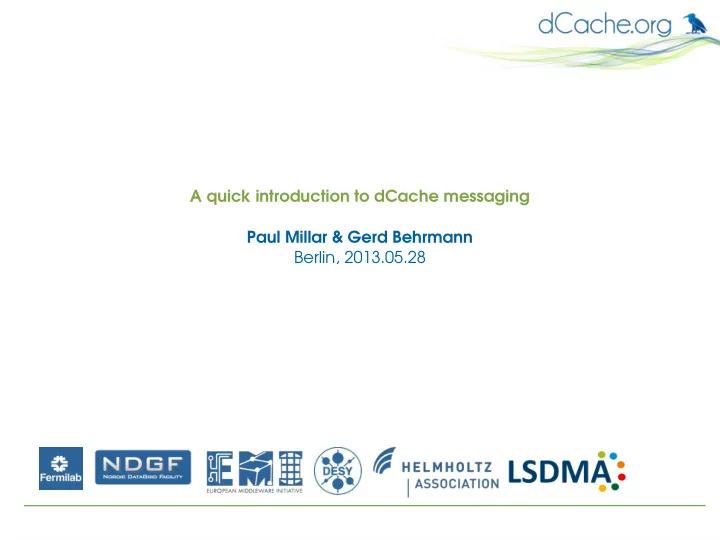

A quick introduction to dCache messaging Paul Millar & Gerd Behrmann Berlin, 2013.05.28
Domains and Cells domainB domainA A B A C A@domainA A@domainB B@domainA C@domainB
Intra-domain messaging domainB domainA A B A C B: sendMessage(“ A ”, “do something”) C: sendMessage(“ A ”, “do something else”)
Intra-domain messaging domainB domainA A B A C B: sendMessage(“ A@domainA ”, “do something”) C: sendMessage(“ A@domainB ”, “do something else”)
Inter-domain communication domainB domainA A B A C B: sendMessage(“ A@domainB ”, “do something”) C: sendMessage(“ A@domainA ”, “do something else”)
Tunnels allow intra-domain communication domainB domainA A B tunnel tunnel A C B: sendMessage(“ A@domainB ”, “do something”)
Routing Table tells cell where to send msg ● Domain has a look-up table ● If a message cannot be delivered locally, then cell looks up where to send it: ● Answer is one of: ● I know for this destination, send it to X ● If have a default destination, send it to Y ● Otherwise fail the request ● If the answer isn't directly deliverable, try again ● Loop 16 times before giving up. ● More about routing and how a domain knows in a bit.
Message routing: multihop domainA domainB A C A A B DomainC
Well-Known cells ● RoutingManager ● One runs in each domain ● Three responsibilities: ● Receives notification of well-known cells ● Maintains routing table for well-known cells ● Sends notification of all the well-known cells it knows of “upstream” (if there is an upstream)
Boot-strapping a topology ● LocationManager ● Client and server ● Single server ● Runs in dCacheDomain, listening on UDP port 11111 by default ● Knows how domains should be wired together (which tunnels should be created) ● Keeps a registry of mappings domain → host:port for tunnels ● Client ● Runs in each domain ● Client asks what should it do? (repeats request every 5 seconds, if no reply) ● Server responds with a list of actions. ● listen on a port, establish a connection to a domain, or establish a default route.
Domain listens ● When LM client told to listen, it: ● starts a new cell, called “l-<num1>” (e.g., “l-101”) ● That cell listens for incoming connections on TCP port 11111 by default. ● Reports back to LM server (via LM client) that domain X is now is listening on a particular host and port-number ● Any incoming connection will create a new cell, called “l-<num1>-<num2>” (e.g., “l-101-102”) ● After an initial handshake, this cell will be one half of a tunnel ● If the connection dies then the l-<num1>-<num2> cell dies
When told to connect ● When told to connect ● Start a new cell, “c-<num1>” e.g. “c-101”. ● Request LocationManager the host and port for the domain it is to connect to (repeat the request if no reply) ● Start a new cell, “c-<num1>-<num2>”, e.g. “c-101-102” to do the actual connect. ● If cannot connect then wait randomly 4—30 seconds and retry. ● Once established and initial handshake completes, this cell is one half of a tunnel. ● If connection dies then the c-<num1>-<num2> cell dies and the c-<num> cell creates a new cell to re-establish the connection.
Default topology domainA domainB A C A B dCacheDomain
Alternative tunnels domainA domainB A C A B OpenMQ broker
Summary ● dCache components communicated by exchanging messages . ● Inter-domain communication achieved using bi-directional tunnels . ● Complicated topologies are possible, but the default is a star, where dCacheDomain is the hub
Recommend
More recommend